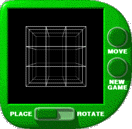 |
Cluster: History
|
 |
"Cluster" was a project I rushed into without doing enough research. It seemed
like such a neat idea -- a real 3D version of the regular worn-out 3D tic-tac-toe,
with an intuitive interface. Hey, it worked for Rubik Unbound.
I'd start with a one-player version (against the computer) and then, if it got
popular, maybe extend it to two players over the Internet.
 On the right is a picture of my original Cluster game, from the spring of 1999.
But it turned out that the 3x3x3 version is fundamentally flawed. The person
or entity who starts will always win, unless he is pretty darn stupid.
A lot of people, who apparently didn't do their research either, wrote and suggested
that I should simply eliminate the center position. That does NOT help, however.
The person who starts still always wins. It's just not as mind-numbingly easy as
when having the middle position.
On the right is a picture of my original Cluster game, from the spring of 1999.
But it turned out that the 3x3x3 version is fundamentally flawed. The person
or entity who starts will always win, unless he is pretty darn stupid.
A lot of people, who apparently didn't do their research either, wrote and suggested
that I should simply eliminate the center position. That does NOT help, however.
The person who starts still always wins. It's just not as mind-numbingly easy as
when having the middle position.
Going to 4x4x4 wasn't an option either. The complexity of the grid would make it too
difficult to see where you moved. But after a while I got a tip about how the game
concept could be salvaged. If the rules were modified so that winning required
two rows, whose ends met at a right angle, it would make things a bit more fair --
or at least not quite as predictable. Worth a shot.
As is often the case, other projects got in the way, but now the new and improved
Cluster is finally up and running. I think it looks fairly impressive. However,
hours of experimenting have led me to believe that even these rules may be flawed
in some way. It might in fact be impossible for anyone to win, provided that both
players have reasonably good strategies. For a while I was convinced that skill level 2
resulted in such a strategy, because I was unable to achieve better than a tied game
no matter what I tried. But then I managed to beat it. In fact, it's disappointingly
easy to outsmart the AI on all levels. I'll leave the exact how as
an exercise for the reader.
|







|





